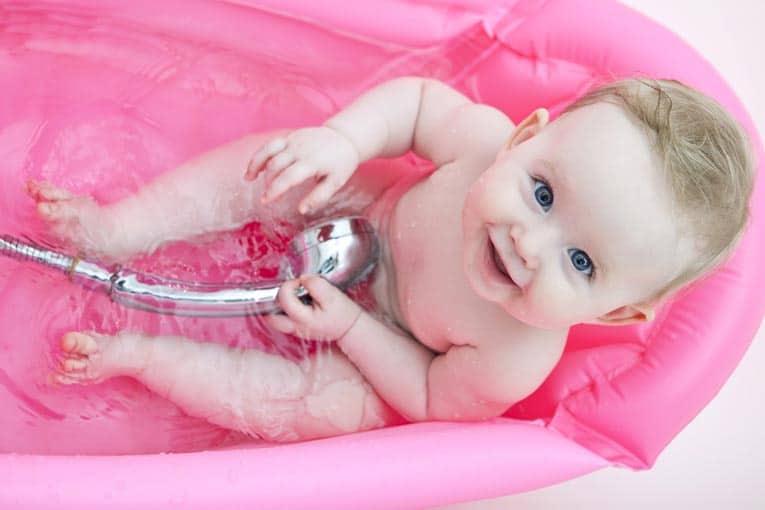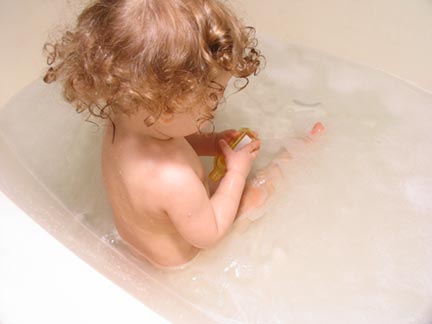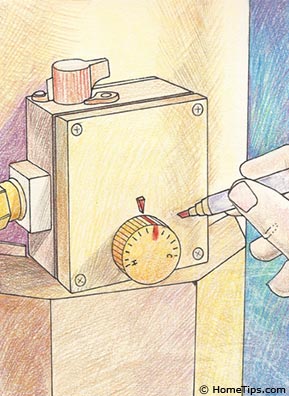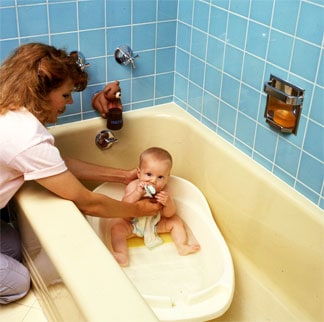Expert advice on childproofing a bathroom, including general bathroom safety tips, advice for turning down the water heater, and tips for bathroom safety equipment.
 Marten_House / Shutterstock.com
Marten_House / Shutterstock.com Baby’s bath is fun and safe, thanks to this inflatable bath cushion.
Medicines that look like candy, slippery tubs and floors, hot water—these are some of the hazards that bathrooms present to curious young children. Here are steps you can take to make your home’s bathrooms as safe as possible.
 AnitaPeppers | MorgueFile
AnitaPeppers | MorgueFile The most critical rule in keeping baby safe at bath time is to never leave her side!
As with the kitchen, first store away and lock up all toxic substances and install a safety lock on the medicine cabinet if it does not have one.
General Bathroom Safety
Keep radios, hair dryers, curling irons, and other electrical appliances out of the bathroom. If there are some you consider essential to your comfort, install GFCIs, unplug the appliances when not in use, and allow them to cool off well out of your child’s reach.
And, keep all electrical appliances a safe distance from the bathtub and sink. Never use extension cords or a portable heater in the bathroom.
So your toddler can’t explore the toilet bowl, buy a simple self-gripping strap to keep the lid down. For the first stage of toilet training, use a “potty chair” that sits on the floor. Then, when your child is ready, move to a step-up training seat that lets him or her use the adult toilet safely. Or you can get a two-stage toilet trainer that does both. Choose a sturdy step-up trainer with a nonslip step and handles to assure that your child can get up and down safely. To add an extra layer of safety when your child is old enough to use the regular toilet, you can look into a model with a soft close lid. Toto toilets have several different models like this but they also provide soft close lids that will work with any toilet.
When childproofing a bathroom, look at the location of the towel bars from a toddler’s vantage point. Could they be used as handrails by a climbing child? Could they poke a small face? If so, change them or move them.
Hide the wastebasket inside a safety-latched cabinet. You can purchase lid-locking diaper pails, a design so practical that you may wish to use a second one as a wastebasket. Even with this precaution, wrap up disposable razors and razor blades and place them in outdoor trash cans immediately after use.
Check the laundry chute or hamper to be sure that baby can’t get trapped in it or fall through it.
Certain kinds of tile and linoleum bathroom floors can be very slippery whether they’re wet or dry. If yours presents this hazard, lay down a rubber-backed bath mat.
Bathtub Safety
Tragically, every year there are incidents of children drowning in the bathtub, so this is an area requiring the strictest vigilance. Never leave your child during a bath—not even for an instant. If you must answer the door or telephone, wrap your baby in a towel and take him or her with you. Drownings can occur in just one or two inches of water and in only a matter of seconds.
Burns from scalding water are a common, yet highly preventable, accident. Reduce the risk of a severe tap-water burn by taking one simple step: Adjust the thermostat on your water heater so that your tap water is no more than 120 degrees F. (This is hot enough for washing dishes and laundry.)

Adjust the water heater dial to the proper temperature, then mark it.
About an hour after turning down the water heater’s thermostat, measure the tap water temperature by placing a cooking thermometer in a glass, running hot water over it for a couple of minutes, and then reading the temperature. You may need to adjust the thermostat dial slightly and test again. When the temperature is right, mark the new, safe level on the thermostat so you will be able to tell if the thermostat has been turned up accidentally.
You can also double-check the water’s temperature with a bathtub thermometer, available at most children’s stores. But you don’t really need one; just feel the water with your elbow (not your hand, which is less sensitive). Fill a baby’s bath with cool water first and then add warm water. Finish with a little cold water to cool off the spout. Check that the water is comfortably warm, about 90 degrees F.
For bathing a baby, use a steady, stable, baby-sized tub either inside the main tub or set on a wide, sturdy counter. Or, while your baby is still small enough, you might prefer using the kitchen sink. For nestling baby comfortably on a hard tub or sink, purchase a special baby-sized sponge mat, and always use one hand to support the baby.
 ©Don Vandervort, HomeTips
©Don Vandervort, HomeTips Baby can enjoy a bath on a comfortable bathtub insert, protected from bumps by the faucet with a soft cover.
After your child outgrows the infant tub, provide a rubberized mat, bathtub friction decals, or nonslip tape in the main bathtub to prevent slipping. Or, for kids from about 6 months to 2 1/2 years old, a special suction-cupped baby support is available at children’s stores. Here, you can also find protectors to cover the tub spout to minimize head bumps and burns.
Sunken and extra deep bathtubs present more than the usual hazard. The closer the tub’s rim to the floor, the more easily a child can climb it and tumble in. If your bathroom has a low-rimmed tub, keep the bathroom door closed at all times.
Be cautious about bathing a child in a spa-type bathtub. Children under 3 often can’t support themselves in the swirling water. If you have this type of tub, don’t run the pump during your young child’s bath.
Don’t bathe your baby in the shower, because the water can unexpectedly become scalding hot. And if your shower or tub has a glass door, it must be safety glass to guard against injury on the day your child decides to pound it with something heavy.
TIP: If you’ve been using automatic toilet-bowl cleaner, remove it from the tank, discard it in the outside trash, and use an alternative means of cleaning the bowl.
